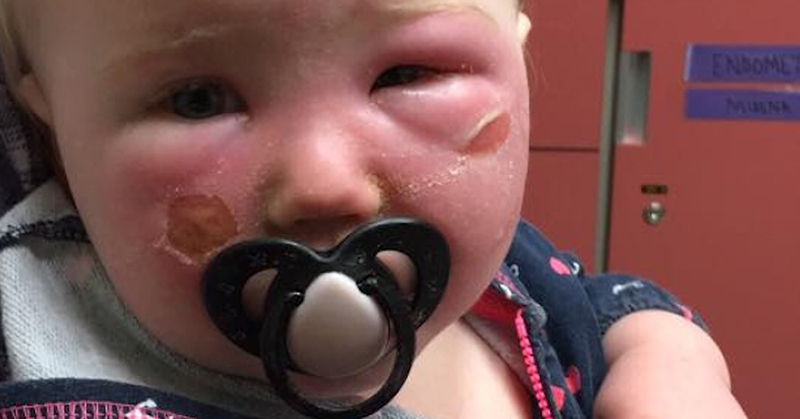This article was originally published on June 6, 2017, and has since been updated.
As a parent, one of your number one concerns is protecting your children from harm. You put covers on outlets and sharp counter corners, keep potentially dangerous medicines well out of reach of little hands, and always ensure that your kids have sunscreen on before going outside.
That’s exactly what 32-year old mom Rebecca Cannon thought she was doing when she put sunscreen on her 14-month-old daughter Kyla’s face before going out to play.
Rebecca and Kyla’s Story
Despite it being an overcast day in late April of 2017 in Newfoundland, Canada, Rebecca still took all the necessary precautions before taking her daughter out to play while visiting her sister. She had forgotten her usual sunscreen at home, and so borrowed some Banana Boat Kids SPF 50 spray sunscreen from her sister. She sprayed the sunscreen on her hands and gently rubbed it onto Kyla’s cheeks and nose, put on her hat and long sleeves, and took her outside.
Almost immediately Kyla’s face began to swell and become red. By the next morning, her whole face was swollen with angry red blisters. She rushed Kyla to the emergency room, where the doctors informed her that her baby girl had second degree burns on her face.
“When it came to having sunscreen on, I thought it was better to have some on than none at all.” Rebecca told Today. “She was the only one who had sunscreen on and she was the only one who got burned.”
What Did the Sunscreen Do?
Kyla was referred to a dermatologist, who determined that the burn was not from the sun, but a “caustic burn” from an ingredient in the sunscreen.
According to Dr. Adam Freidman (not the dermatologist who worked with Kyla) most likely what happened to Kyla was a form of contact dermatitis from an irritant in the sunscreen. Common sunscreen ingredients that could have caused this include alcohol and vitamin C. It was an irritant reaction, not caused by something unique to this specific product.
Guidelines for Sun Protection for Babies and Kids
Dr. Friedman reminds us that when it comes to kids and sunscreen, it is not a one size fits all scenario.
“There are specific sunscreens for different ages because there are unique biological differences at different ages.”
Infant skin, he says, is highly sensitive and much more irritable. It is important that parents take extra care and precaution when thinking about sun protection for their children.
5 Tips for Protecting Your Babies and Kids from the Sun
1. Use Mineral Sunscreens
While many kids’ sunscreens state that they are safe for kids of all ages to use, Dr. Friedman recommends that until your child is four or five, stick to mineral sunscreens. Choose zinc oxide or titanium dioxide-based products for kids under five.
2. Put Sunscreen on Your Hands and Gently Rub into Your Child’s Skin
Rebecca was right in first spraying the sunscreen on her hands, then rubbing it on Kyla’s face. This ensures better coverage and not having places where the product is more concentrated on your child’s skin.
3. Reapply Every 2hrs and After Swimming
Most of us remember to put sunscreen on our kids at the beginning of the day, but before we know it hours have gone by without putting more on. Kid’s skin (especially infants and toddlers) burns more easily, so it is important to take time every two hours to reapply to all exposed skin, and particularly after swimming or other water activities (sprinklers, splash pads, etc.).
Also, don’t forget to wait a half hour or so after applying sunscreen before allowing your kids in the water, even if it’s “water proof”.
4. Wear Hats and Protective Clothing
Hats and proper clothing provide far more sun protection than sunscreen that lasts all day. Make sure your kids wear wide brimmed hats, sunglasses, and long sleeved, light clothing. This will not only protect them from the sun, but will also help to keep them cooler.
On days where the UV index is particularly high, have your kids wear full-coverage bathing suits, or at least wear a t-shirt in the pool. If your kids are wearing normal, cotton t-shirts while swimming, make sure they stay in the shallow end and always have parental supervision, as wet clothes can become heavy and difficult to swim in.
5. Stay in the Shade as Much as Possible
Try your best to limit the amount of direct sun exposure to your kids. Find places to play and sit that are shaded by trees or buildings, or bring your own beach umbrella to the park or beach to ensure a shady spot for your kids to play.
On days when the UV index is high, make sure your kids stay in the shade, or choose indoor activities to do on those days.
Sun protection is important for people of all ages, but especially for your kid’s sensitive and vulnerable skin. Skin cancer is the most common cancer in America, and most cases of skin cancer are actually caused by cumulative skin damage from years prior, especially from burns before the age of 18. (2)
Rebecca wants all parents to be aware of what happened to her daughter, and along with her we want to encourage all parents to spread the word and understand the importance of sun protection in their children’s health.
Sources
- “FDA says it causes cancer. Yet it’s in hundreds of candies.” Center for Science in the Public Interest. October 25, 2022.
- “What Is Red No. 3 (Erythrosine) And Why It’s in Your Food?” Eat This. Desirée O. March 23, 2022
- “Food Dyes: Harmless or Harmful?” Healtline. Becky Bell, MS, RD. January 7, 2017.

